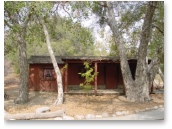 Located in Placerita Canyon, the Walker Ranch was named for the area’s first homesteader, Frank Evans Walker, and features cool, shaded oak groves and a seasonal stream lined with willows and sycamores. The cabin pictured at right was built by Frank Walker in 1920 as a home for his family, and they lived there until about 1930. Many Westerns were filmed in and around this cabin during the 1930s-1950s, and of the many cabins that were once on the property, it is the only one that remains.
Located in Placerita Canyon, the Walker Ranch was named for the area’s first homesteader, Frank Evans Walker, and features cool, shaded oak groves and a seasonal stream lined with willows and sycamores. The cabin pictured at right was built by Frank Walker in 1920 as a home for his family, and they lived there until about 1930. Many Westerns were filmed in and around this cabin during the 1930s-1950s, and of the many cabins that were once on the property, it is the only one that remains.
Placerita Canyon was once part of a land grant bounded by Piru Creek on the west and Elsmere Canyon on the east. In 1839, Mexican Lieutenant Antonio del Valle acquired the land from California Governor Juan B. Alvarado.
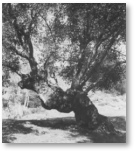 The del Valle family's rancho was stocked with cattle, sheep, and horses and was headquartered at the Asistencia de San Francisco Javier at present day Castaic Junction. Jose Francisco de Garcia Lopez, an uncle of Antonio del Valle’s second wife, leased some of the land from the del Valles to raise his own cattle. Legend has it that on his 40th birthday, Francisco Lopez, while deep in the Canyon de los Encinos (Live Oak Canyon), selected a spot underneath an old oak tree for his noon siesta. Following his nap, in which he dreamed of floating on a sea of gold, he dug up some wild onions with his knife and found gold clinging to the roots. This remarkable discovery on March 9, 1842, six years before James Marshall plucked a golden nugget out of the American River while helping John Sutter build his sawmill, marked the first discovery of gold in California and prompted the state’s first gold rush. Hundreds of prospectors flocked from Los Angeles and Sonora, Mexico, to Live Oak Canyon, which was later renamed Placerita Canyon. From 1842 to 1847 approximately 1,300 pounds of placer gold deposits were mined from Placerita. In 1848, the Treaty of Guadalupe Hidalgo turned California over to the United States and many of the Santa Clarita Valley's early prospectors returned to Mexico.
The del Valle family's rancho was stocked with cattle, sheep, and horses and was headquartered at the Asistencia de San Francisco Javier at present day Castaic Junction. Jose Francisco de Garcia Lopez, an uncle of Antonio del Valle’s second wife, leased some of the land from the del Valles to raise his own cattle. Legend has it that on his 40th birthday, Francisco Lopez, while deep in the Canyon de los Encinos (Live Oak Canyon), selected a spot underneath an old oak tree for his noon siesta. Following his nap, in which he dreamed of floating on a sea of gold, he dug up some wild onions with his knife and found gold clinging to the roots. This remarkable discovery on March 9, 1842, six years before James Marshall plucked a golden nugget out of the American River while helping John Sutter build his sawmill, marked the first discovery of gold in California and prompted the state’s first gold rush. Hundreds of prospectors flocked from Los Angeles and Sonora, Mexico, to Live Oak Canyon, which was later renamed Placerita Canyon. From 1842 to 1847 approximately 1,300 pounds of placer gold deposits were mined from Placerita. In 1848, the Treaty of Guadalupe Hidalgo turned California over to the United States and many of the Santa Clarita Valley's early prospectors returned to Mexico.
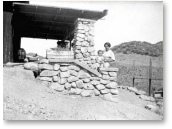 In the late 1800s, Los Angeles residents William Raymond Walker and Rosa Belle Evans acquired mining concerns in Placerita Canyon. The Walker family legacy did not, however, begin in Placerita Canyon until their son Frank built a home for his family there in 1909. Taking advantage of the area's historical past, entrepreneur Frank Walker publicly promoted the ranch property as a gold panning camp. Walker's Placerita Camp offered furnished housekeeping cabins, picnic grounds with private tables and outdoor stoves, as well as special barbecue dinners. The original Walker house burned down in 1918. The family moved down the canyon to another cabin on the ranch, which is now located on the county-run Placerita Canyon Nature Center property.
In the late 1800s, Los Angeles residents William Raymond Walker and Rosa Belle Evans acquired mining concerns in Placerita Canyon. The Walker family legacy did not, however, begin in Placerita Canyon until their son Frank built a home for his family there in 1909. Taking advantage of the area's historical past, entrepreneur Frank Walker publicly promoted the ranch property as a gold panning camp. Walker's Placerita Camp offered furnished housekeeping cabins, picnic grounds with private tables and outdoor stoves, as well as special barbecue dinners. The original Walker house burned down in 1918. The family moved down the canyon to another cabin on the ranch, which is now located on the county-run Placerita Canyon Nature Center property.
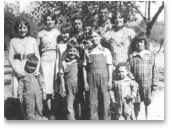 At one point, the Walker clan included twelve children and had two homes, both a winter and a summer cabin. The winter home was apparently needed because the road near the summer home became impassable during the winter. Eventually in the late 1930s, the family moved permanently into the summer cabin, which had two main rooms and separate sleeping cabins for the children.
At one point, the Walker clan included twelve children and had two homes, both a winter and a summer cabin. The winter home was apparently needed because the road near the summer home became impassable during the winter. Eventually in the late 1930s, the family moved permanently into the summer cabin, which had two main rooms and separate sleeping cabins for the children.
From Hollywood’s earliest years, the Walker Ranch was rented out to filmmakers, an enterprise that afforded the Walkers extra income. Production companies that used the ranch as a backdrop include Columbia, Universal, RKO, Republic, Monogram, PRC, Grand National and Spectrum. William S. Hart, the famous cowboy star, was a neighbor and friend of the Walkers and during the 1920s used the Walker property for film shoots. Other Western stars who used the ranch in their silver screen productions include Buck Jones, Tim McCoy, John Wayne, Bob Steele, Ken Maynard, Johnny Mack Brown, Eddy Dean, Tim Holt, and Roy Rogers. According to one of the children, Tom Walker, the first film to be shot at the Walker Ranch was in 1928. Film crews were charged $5 a day. From the early 1930s to the early 1950s, hundreds of B-Westerns were filmed at the ranch, whose most distinctive on-screen feature was what is referred to as the “Walker Cabin”, front-lined with sycamores and typically referred to as “the hideout.” Many of the ranch’s cabins were used in filming; however, the only building that remains today is the Walker Cabin. The road that runs along the front of it and the road on the other side of the creek (south side) were used for many of the chase scenes lensed on the property. Films in which these roads and the Cabin can be seen include Buck Jones' The Range Feud (1931) and Tim McCoy's Two-Fisted Law (1932), both made by Columbia and featuring a very young John Wayne; Bob Steele's Durango Valley Raiders (1938) made by Republic; Buck Jones' and Tim McCoy's West of the Law (1942), the eighth installment of Monogram’s nine-part Rough Riders series; Ken Maynard's Blazing Guns (1943), the third entry of Monogram’s eight-part Trail Blazers series; Johnny Mack Brown's Raiders of the Border (1944), part of Monogram’s Nevada Jack McKenzie series, and Trailing Danger (1947), also from Monogram; Roy Rogers' Eyes of Texas (1948) and Down Dakota Way (1949), both filmed by Republic in Trucolor; and Tim Holt's Robbers of the Range (1941), Overland Telegraph (1951), and Road Agent (1952), all from RKO.
In the late 1950s, the Walt Disney Company took over a portion of the property that was located off the Placerita Canyon Road and named it Golden Oak Ranch. The portion containing the Walker Cabin and chase roads was sold to the State of California to be used for a park. In recent years, the State transferred ownership of the Placerita Canyon Park to the County of Los Angeles. Incidentally, the oak tree beneath which Francisco Lopez took his famous siesta - Oak of the Golden Dream - is located within Disney's acquisition; however, the California Historic Landmark monument that commemorates the actual event is located near the Placerita Canyon Nature Center within Placerita Canyon Park.
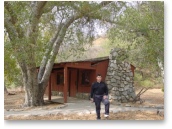 Designated a Nature Area, Placerita Canyon Park and Nature Center is located southeast of Santa Clarita and encompasses 351 acres containing oak woodlands and chaparral on the north side of the San Gabriel Mountains. The Nature Center contains exhibits on the natural history of Southern California, as well as a network of self-guided nature, history, and hiking trails radiating out from the Center. Placerita Canyon Park and Nature Center may be reached from Los Angeles by taking Interstate 5 north to Highway 14, and exiting right at Placerita Canyon Road. Go past the Andy Jauregui Ranch site and Walt Disney's Golden Oak Ranch (both on the left side of the road), then look for the Placerita Canyon Park on the right side to enter. This is the old Walker Ranch. The Walker Cabin is between the entrance of the Park and the Nature Center, on the left and next to the parking area.
Designated a Nature Area, Placerita Canyon Park and Nature Center is located southeast of Santa Clarita and encompasses 351 acres containing oak woodlands and chaparral on the north side of the San Gabriel Mountains. The Nature Center contains exhibits on the natural history of Southern California, as well as a network of self-guided nature, history, and hiking trails radiating out from the Center. Placerita Canyon Park and Nature Center may be reached from Los Angeles by taking Interstate 5 north to Highway 14, and exiting right at Placerita Canyon Road. Go past the Andy Jauregui Ranch site and Walt Disney's Golden Oak Ranch (both on the left side of the road), then look for the Placerita Canyon Park on the right side to enter. This is the old Walker Ranch. The Walker Cabin is between the entrance of the Park and the Nature Center, on the left and next to the parking area.